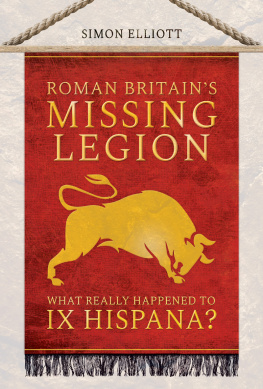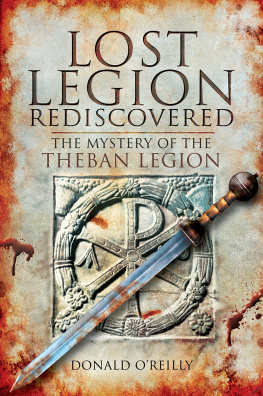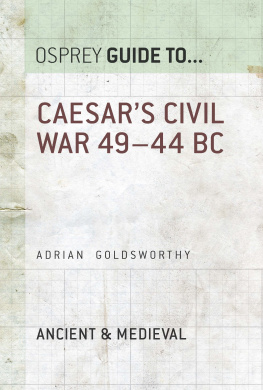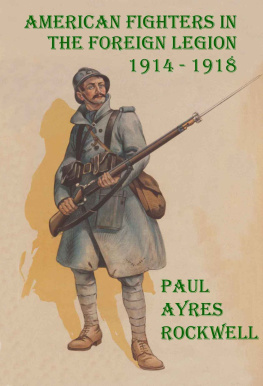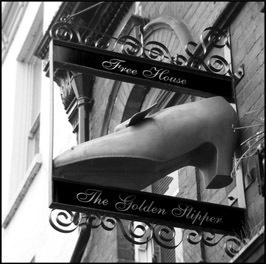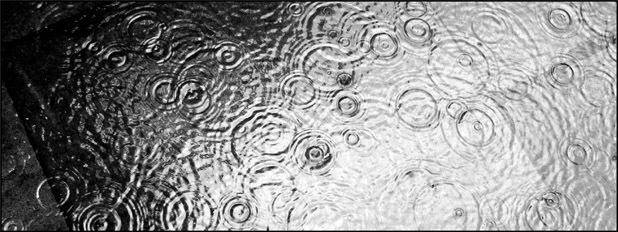THE DISAPPEARING NINTH LEGION
A POPULAR HISTORY
(Loosely based on: The Ninth Legion, Its History And
Mysterious Disappearance, John Aspin Publications, 1997)
MARK OLLY
WITH JOHN ASPIN
Winchester, UK
Washington, USA
First published by O-Books, 2011
O-Books is an imprint of John Hunt Publishing Ltd., Laurel House, Station Approach,
Alresford, Hants, SO24 9JH, UK
office1@o-books.net
www.o-books.com
For distributor details and how to order please visit the Ordering section on our website.
Text copyright: Mark Olly and John Aspin 2010
ISBN: 978 1 84694 559 5
All rights reserved. Except for brief quotations in critical articles or reviews, no part of this book may be reproduced in any manner without prior written permission from the publishers.
The rights of Mark Olly and John Aspin as authors have been asserted in accordance with the Copyright, Designs and Patents Act 1988.
A CIP catalogue record for this book is available from the British Library.
Design: Stuart Davies
Printed in the UK by CPI Antony Rowe
Printed in the USA by Offset Paperback Mfrs, Inc
We operate a distinctive and ethical publishing philosophy in all areas of our business, from our global network of authors to production and worldwide distribution.
Mark Olly would like to dedicate this book to Andrea Thomason, My first love, lost for many years but now found.
John Aspin would like to dedicate this book to his late mother
Winnefred Mary Aspin,
1917 to 2009.
This book constitutes a modern adaptation of primarily original Roman source material found in Tacitus Annals Of Imperial Rome, Julius Caesars Gallic Wars & Conquest Of Gaul, Frontos Letters, and a host of antiquarian & archaeological publications covering 300 years of research not readily available to todays public.
THANKS/DEDICATIONS ETC.
Mark Olly received much help in the preparation of this work & would like to express his gratitude to the following for their assistance: John Aspin, Andrea Thomason for getting this project moving again, Mum & Dad for inspiration, Helen Maria Carr for critically reviewing the first draft, Phil Hirst & all the Lost Treasures/Britains Lost Mega Fortress TV programs Roman advisers, many archaeologists (you know who you are!) & Roman re-enactors in York & Chester, without whose enthusiasm & encouragement this book would never have been completed.
John Aspin received much help in the preparation of this work & would like to express his gratitude to the following for their assistance: Mark Olly, Graham Browne, Dr James Cantlie, Karen Svanso & Tracy Fitzsimons for illustrations, Alison Player, Nigel Player, Nike French, Victoria Aspin, York Library, Glossop Library, Carlisle Museum. John Aspin would also like to acknowledge the help & encouragement he had from the late Dr Derryck Ward, & also the invaluable help from Dr Patrick Ottaway of the York Archaeological Trust who continue the work to this day.
:..
I
INTRODUCTION - THE GOLDEN SLIPPER
A summer shower was pouring from the heavens when I met John outside the Golden Slipper in York, a tiny pub on the edge of The Shambles built in the 15 and 16 centuries, and given a somewhat quirky brick faade in the industrial enthusiasm of the 19 century.
The earliest account of the place reads: John Armstrong was returning from having a few at the sign of The Slipper in Goodramgate when William Brown had severely beaten and thrown him into the river until he was stiff and stagnated with cold.
Thats how I felt as we shook the water from our coats and settled in for lunch and a few of our own. At least I wasnt about to be hanged on Baille Hill for robbery like William Brown had been, as reported in the York Gazette of 17 th March 1821! As always discussion turned to the fact that no popular book had yet been written about the foundation of York city by the Roman Ninth Legion.
I mused: I hate Romans! The world we now live in is dominated by Roman ways and Roman thoughts, frequently without any regard for those cultures they conquered and absorbed into the Empire. Im a big fan of those cultures, the Celts. So why should I write a book devoted to some of the greatest battles, conquests, and political issues to occur in over a thousand years of Roman history?
John was persuasive: I love a good mystery, dont you? It was this aspect, the disappearance of an entire Legion apparently somewhere in the UK, that first caught my attention years ago. Then to find that no popular history of this Legion and these events had ever been written beyond the pages of fiction came as a bit of a shock!
John won his argument and here it is, The Disappearing Ninth Legion, A Popular History, historic research and concept by John Aspin, written and photographed by myself, Mark Olly.
Whether you are a fan of the Romans or not, you will find this fast-paced account a gripping historic whodunnit which may never have a satisfactory resolution unless, one day, you meet a bedraggled Legion of defeated soldiers trudging through the mists on some forgotten moorland road, or the ghost of a skin-cloaked standard bearer still desperately searching for his missing golden eagle!
Mark Olly (Summer 2010 AD).
York: Ebur, Eburacum (Antonian Itinerary C.380 AD) / Eboracensis, Euborica, Eoforwic (Old English Chronicles C.780 AD) / Caer Ebrauc, Eferwic, Eurvich (Domesday 1086 AD & Layam 1205 AD).
All we know of the area around York before the arrival of the Romans is a collection of small Iron Age farmsteads which can be seen surrounding the city on aerial photographs and satellite images, but not yet ever found within the city. The ancient Roman historian Ptolemy mentions Eborakon as one of the settlements of the Brigantes, a tribe which occupied the whole of Northern England before and throughout the Roman occupation and the probable owners of the local farmsteads.
The name is said to originate from the Irish-Gaelic ebrach, meaning muddy or a marsh ending in ach meaning place of. The Angles may have taken it to be town, dwelling (wic) on the river (Ure) and it is this Eure which looks like iubhar/ibar which has led to a yew and the interpretation the place of the yews.
Given that this could equate to a grove of yew trees located in a marsh, it has been said that the Romans took over a Druid sacred site and retained its original name as they had done elsewhere.
Was it this act that brought down the original curse on the Unlucky Ninth?



